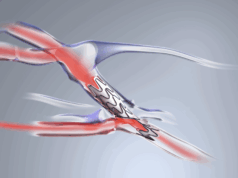 A patient-level meta-analysis of randomised controlled trials (RCTs) has shown that drug-coated balloons (DCBs) were “consistently favoured” over percutaneous transluminal angioplasty (PTA) to prolong target lesion primary patency and access circuit primary patency in the treatment of dysfunctional haemodialysis venous access. The research, authored by Khi Yung Fong, Joseph J Zhao (both National University of Singapore, Singapore), Chow Wei Too (SingHealth-Duke-NUS Academic Medical Centre, Singapore), and colleagues, was recently published online in the European Journal of Vascular and Endovascular Surgery (EJVES).
A patient-level meta-analysis of randomised controlled trials (RCTs) has shown that drug-coated balloons (DCBs) were “consistently favoured” over percutaneous transluminal angioplasty (PTA) to prolong target lesion primary patency and access circuit primary patency in the treatment of dysfunctional haemodialysis venous access. The research, authored by Khi Yung Fong, Joseph J Zhao (both National University of Singapore, Singapore), Chow Wei Too (SingHealth-Duke-NUS Academic Medical Centre, Singapore), and colleagues, was recently published online in the European Journal of Vascular and Endovascular Surgery (EJVES).
This is the first patient-level, RCT-only meta-analysis comparing DCB with PTA in haemodialysis access restenosis, the authors claim. They detail that a total of 11 RCTs, comprising 1,347 patients, were included in their analysis. Fong, Zhao, Too et al add that two of the studies analysed were published as recently as 2020.
The authors report that, among 10 RCTs (1,207 patients), hazard ratios (HRs) across all models favoured DCB (one-stage shared frailty HR 0.62, 95% confidence interval [CI] 0.53–0.73, p<0.001); two-stage random effects HR 0.6, 95% CI 0.42–0.86, p=0.018, I2=65%) for target lesion primary patency.
In addition, they found that target lesion primary patency restricted mean survival times were +3.54 months (25%) longer in patients who received DCB treatment compared with PTA (p=0.001) at three years.
Target lesion primary patency at six months, one year, and two years was 75.3% vs. 58.1%, 51.1% vs. 37.1%, and 31.4% vs. 26% for DCB and PTA, respectively, Fong, Zhao, Too, and colleagues relay.
An “intriguing” finding relates to paclitaxel dose, the authors detail, noting that the p-scores within a Frequentist network meta-analysis suggest higher concentrations of paclitaxel were associated with better target lesion primary patency and access circuit primary patency.
The authors further report that, among six RCTs (854 patients), a one-stage model favoured DCB (shared frailty HR 0.72, 95% CI 0.6–0.87, p<0.001) for access circuit primary patency. However, they add, a two-stage random effects model demonstrated no significant difference (HR 0.76, 95% CI 0.35–1.67, p=0.41, I2=81%).
Notwithstanding, the investigators relay that sensitivity analysis for access circuit primary patency excluding outliers significantly favoured DCB (HR 0.61, 95% CI 0.41–0.91, p=0.027, I2=62%).
Detailing certain limitations of their research, Fong, Zhao, Too et al acknowledge that their analyses were unable to account for competing risks to restenosis, such as patient mortality, for which previous studies yielded mixed findings. In addition, they stress that clinical judgement to proceed with either DCB or PTA should be considered alongside the side-effects of paclitaxel, effectiveness of prior PTA, procedure-related morbidity, and cost-benefit analysis, which were “beyond the scope of the present article”.
In concluding, the authors write that their research “represents a statistically robust and up-to-date comparison between DCBs and PTA”. Looking ahead, they suggest that future investigations should focus on dose-efficacy relationships and explore how lesion-specific covariates, such as age, length, location, type, and balloon diameter may affect DCB versus PTA outcomes for haemodialysis access restenosis.












